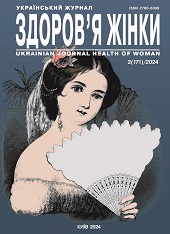Management of women with cervical insufficiency - transformation of views
DOI:
https://doi.org/10.15574/HW.2024.171.26Keywords:
preterm labor, isthmico-cervical insufficiency, cervical cerclage, cervical suturingAbstract
Cervical cerclage is an obstetric procedure used to prevent late term spontaneous abortions and preterm birth in women at high risk of miscarriage. Taking into consideration existance of insufficient effectiveness of methods for preventing spontaneous preterm labor, as evidenced by the lack of significant changes in statistical data over the past 10 years, further research is needed to improve the tactics of managing pregnant women, especially from the group of high risk of this complication. Cervical cerclage allows to mechanically stop the process of spontaneous opening of the cervix, however, although the method is minimally invasive, when using it, there is still a risk of complications, such as infection or trauma to the cervix. Taking this into account, determining the groups of patients who will benefit the most from this intervention is essential. Today, this issue is undergoing a number of transformations and updates which we tried to analyze in this work.
Aim - determining changes in the recommendations for surgical management of women with isthmico-cervical insufficiency based on the analysis of the latest recommendations of the National Institute for Health and Care Excellence and the Royal College of Obstetricians and Gynecologists.
Results and conclusions. According to the 2022 guidelines, along with slightly changed approaches to the classification and terminology of cervical cerclage, there has been some transformation in views about the groups of women who will benefit the most from the procedure. First of all, according to anamnestic data, cervical suture is recommended for three anamnestic episodes of miscarriage instead of two in the previous recommendations. On ultrasound examination, a wedge-shaped transformation of the cervix and incidental detection of cervical shortening after 20 weeks is not an indication for applying a cerclage, since the effectiveness of the intervention in this case is unproven. In addition, new techniques, such as abdominal cerclage, have been invented to more effectively prevent episodes of miscarriage.
No conflict of interests was declared by the authors.
References
ACOG (2014, Feb). Cerclage for the management of cervical insufficiency. Practice Bulletin No.142. Obstet Gynecol. 123; 2 Pt 1: 372-379. https://doi.org/10.1097/01.AOG.0000443276.68274.cc; PMid:24451674
Berghella V, Gulersen M, Roman A, Boelig RC. (2023). Vaginal progesterone for the prevention of recurrent spontaneous preterm birth. American journal of obstetrics & gynecology MFM. 5(10): 101116. https://doi.org/10.1016/j.ajogmf.2023.101116; PMid:37543143
Choorakuttil RM, Rajalingam B, Satarkar SR, Sharma LK, Gupta A, Baghel A, Nirmalan PK. (2022). Preterm Birth Rates after Initiating the Third-Trimester Screening Protocol of Samrakshan in India: Initial Results. Indian Journal of Radiology and Imaging. 33(1): 101-103. https://doi.org/10.1055/s-0042-1758878; PMid:36855731 PMCid:PMC9968537
Clark NV, Einarsson JI. (2020). Laparoscopic abdominal cerclage: a highly effective option for refractory cervical insufficiency. Fertility and Sterility. 113(4): 717-722. https://doi.org/10.1016/j.fertnstert.2020.02.007; PMid:32147177
Curran M. (2023). Reviewed by Medical Advisory Board. URL: https://www.perinatology.com/ultrasound/Short%20Cervix.htm
Fox NS, Chervenak FA. (2008). Cervical Cerclage: A Review of the Evidence. Obstetrical & Gynecological Survey. 63(1): 58-65. https://doi.org/10.1097/OGX.0b013e31815eb368; PMid:18081941
Golyanovsky ОV, Morozova OZ, Supruniuk KV, Frolov SV. (2023). The role of isthmic-cervical insufficiency in miscarriage. Reproductive health of woman. (7): 53-60. https://doi.org/10.30841/2708-8731.7.2022.272473
Gulersen M, Lenchner E, Nicolaides KH, Otsuki K, Rust OA, Althuisius S et al. (2023). Cervical cerclage for short cervix at 24 to 26 weeks of gestation: systematic review and meta-analysis of randomized controlled trials using individual patient-level data. American journal of obstetrics & gynecology MFM. 5(6): 100930. https://doi.org/10.1016/j.ajogmf.2023.100930; PMid:36924844
Jiang H, Bo Z. (2024). Application value of ultrasound elastography for screening of early pregnancy cervical insufficiency: a retrospective case-control study. The Journal of Maternal-Fetal & Neonatal Medicine. 37(1). https://doi.org/10.1080/14767058.2023.2299111; PMid:38199820
Lesser KB, Childers JM, Surwit EA. (1998). Transabdominal cerclage: a laparoscopic approach. Obstetrics and gynecology. 91; 5 Pt 2: 855-856. https://doi.org/10.1016/S0029-7844(97)00655-8; PMid:9572190
Mhatre M, House M. (2019). Cervical Insufficiency and Cervical Cerclage. DeckerMed Obstetrics and Gynecology. https://doi.org/10.2310/OBG.19057
National Institute for Health and Care Excellence. (2015). Preterm Labour and Birth. NICE guideline 25. London.
Ohuma EO, Moller A-B, Bradley E et al. (2023, Oct 7). National, regional, and global estimates of preterm birth in 2020, with trends from 2010: a systematic analysis. The Lancet. 402(10409): 1261-1271. https://doi.org/10.1016/S0140-6736(23)00878-4; PMid:37805217
Shennan AH, Story L. (2022). Cervical Cerclage. Royal College of Obstetricians and Gynaecologists (RCOG). Green-top Guideline No. 75. BJOG. 129: 1178-1210. https://doi.org/10.1111/1471-0528.17003; PMid:35199905
Downloads
Published
Issue
Section
License
Copyright (c) 2024 Ukrainian Journal Health of Woman

This work is licensed under a Creative Commons Attribution-NonCommercial 4.0 International License.
The policy of the Journal UKRAINIAN JOURNAL «HEALTH OF WOMAN» is compatible with the vast majority of funders' of open access and self-archiving policies. The journal provides immediate open access route being convinced that everyone – not only scientists - can benefit from research results, and publishes articles exclusively under open access distribution, with a Creative Commons Attribution-Noncommercial 4.0 international license (СС BY-NC).
Authors transfer the copyright to the Journal UKRAINIAN JOURNAL «HEALTH OF WOMAN» when the manuscript is accepted for publication. Authors declare that this manuscript has not been published nor is under simultaneous consideration for publication elsewhere. After publication, the articles become freely available on-line to the public.
Readers have the right to use, distribute, and reproduce articles in any medium, provided the articles and the journal are properly cited.
The use of published materials for commercial purposes is strongly prohibited.

